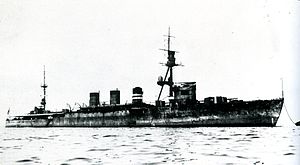Japanese cruiser Ōi

Ōi in 1923 at Kure Harbor, Hiroshima
|
|
| History | |
|---|---|
|
|
|
| Name: | Ōi |
| Namesake: | Ōi River |
| Ordered: | 1917 Fiscal Year |
| Builder: | Kawasaki Shipbulding, Kobe, Japan |
| Laid down: | 24 November 1919 |
| Launched: | 15 July 1920 |
| Commissioned: | 10 October 1921 |
| Out of service: | 19 July 1944 |
| Struck: | 10 September 1944 |
| Fate: | Torpedoed by USS Flasher 570 nmi (1,060 km; 660 mi) south of Hong Kong, South China Sea at 13°12′N 114°52′E / 13.200°N 114.867°E, 19 July 1944 |
| General characteristics | |
| Class and type: | Kuma class light cruiser |
| Displacement: | 5,100 long tons (5,200 t) (standard) |
| Length: | 152.4 m (500 ft 0 in) |
| Beam: | 14.2 m (46 ft 7 in) |
| Draft: | 4.8 m (15 ft 9 in) |
| Installed power: | 90,000 shp (67,000 kW) |
| Propulsion: |
|
| Speed: | 36 kn (67 km/h; 41 mph) |
| Range: | 5,000 nmi (9,300 km; 5,800 mi) at 14 kn (26 km/h; 16 mph) |
| Complement: | 450 |
| Armament: |
|
| Armor: | |
| Aircraft carried: | 1 × floatplane |
| Aviation facilities: | 1 × catapult |
Ōi (大井?) was the fourth of five Kuma-class light cruiser, which served in the Imperial Japanese Navy during World War II. She was named after the Ōi River in Shizuoka prefecture, Japan. Designed as a command vessel for a destroyer squadron, she was converted into a torpedo cruiser with forty torpedo launch tubes in a plan abandoned by the Japanese Navy in 1942. During most of the Pacific War, she was used primarily as a fast troop transport and was sunk by a United States Navy submarine in 1944.
After the construction of the Tenryū-class cruisers, the demerits of the small cruiser concept became apparent. At the end of 1917, plans for an additional six Tenryū-class vessels, plus three new-design 7,200 long tons (7,300 t)-class scout cruisers were shelved, in place of an intermediate 5,500 long tons (5,600 t)-class vessel which could be used as both a long-range, high speed reconnaissance ship, and also as a command vessel for destroyer or submarine flotillas. Kuma was the lead ship of the five vessels in this class which were built from 1918-1921.
The Kuma-class vessels were essentially enlarged versions of the Tenryū-class cruisers, with greater speed, range, and weaponry.
With improvements in geared-turbine engine technology, the Kuma-class vessels were capable of the high speed of 36 kn (41 mph; 67 km/h), and a range of 9,000 nmi (17,000 km; 10,000 mi) at 10 kn (12 mph; 19 km/h). The number of 14 cm/50 3rd Year Type naval guns was increased from three on the Tenryū class to seven on the Kuma class and provision was made for 48 naval mines. However, the two triple torpedo launchers on the Tenryū class was reduced to two double launchers, and the Kuma class remained highly deficient in anti-aircraft protection, with only two 8 cm/40 3rd Year Type naval guns .
...
Wikipedia
